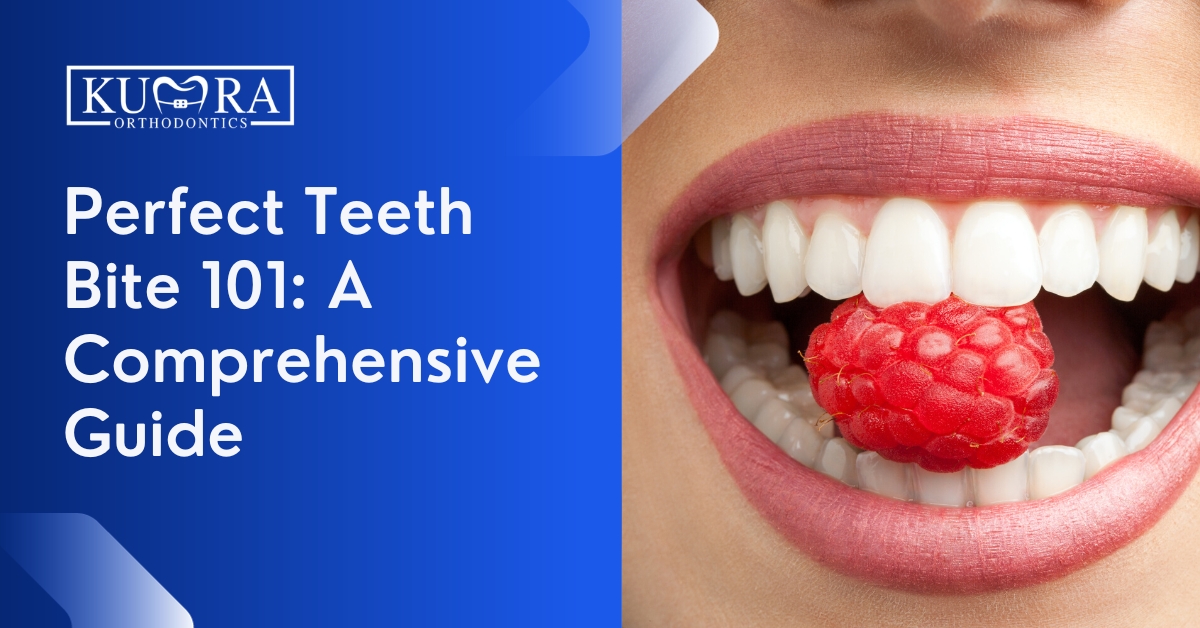Are you striving for the perfect teeth bite? You’re not alone. Statistically, only about 35% of adults naturally possess a perfect bite. It means the majority, including you perhaps, may have some form of malocclusion or a less-than-ideal bite alignment.
Roughly 20% of people have noticeable deviations from the optimal bite relationship, with a smaller percentage, around 2%, facing severe deviations that pose a challenge for orthodontic intervention.
At Kumra Orthodontics, we’re committed to turning these statistics around for you. This comprehensive guide is your roadmap to achieving the ideal teeth alignment. We believe in empowering you with knowledge and solutions, ensuring you’re equipped to make informed decisions about your orthodontic care.
What is “Bite” in Orthodontics?
In the world of orthodontics, the term bite refers to the specific manner in which your upper and lower teeth come together when your mouth is closed. Think of it as the cornerstone of oral alignment, encompassing the positioning and interaction between your teeth, jawbones, and the complete structure of your oral cavity.
Bite’s Crucial Role in Dental Health
A proper bite is about more than teeth simply meeting each other; it’s about ensuring a harmonious relationship within your mouth. When your bite is aligned correctly, you can chew, speak, and even breathe more effectively. It’s vital for preventing strain on your jaw and teeth, safeguarding against issues like jaw pain, headaches, and even long-term temporomandibular joint (TMJ) disorders.
Aesthetic Implications of a Well-Aligned Bite
Aesthetically, a well-aligned bite contributes significantly to the symmetry of your smile and the overall balance of your facial appearance. A proper bite alignment can enhance not just the look of your smile but also the contours and proportions of your face, offering both cosmetic and functional benefits.
What Constitutes a Perfect Teeth Bite?
Oral health is a multifaceted aspect of our overall wellness, often encapsulated by the focus on preventing tooth decay, maintaining gum health, and practicing impeccable oral hygiene. However, there’s another fundamental component that plays a significant role in our dental health — the way our teeth align or the ‘bite’.
Front View
When observed from the front, an ideal dental bite presents a slight overlap of the upper front teeth over the lower ones. The configuration allows the molar points to fit snugly into the opposite molar grooves.
Additionally, the midlines between your upper and lower front teeth should ideally align with your facial center. The balanced alignment not only provides a visually pleasing and symmetrical appearance but also ensures the optimal functionality of your teeth.
Side View
Examining your bite from a side view, the ideal alignment demonstrates a smooth curve running from the front to the back of your teeth. The arc, known as the ‘Curve of Spee’, is ideally shallow.
A curve that’s too steep or too flat could indicate a potential bite issue. Moreover, when you close your mouth, your upper teeth should ideally sit just outside your lower teeth.
Top-View
From a bird’s eye view or top perspective, the perfect bite showcases an arch form in both the upper and lower jaw. The upper teeth should ideally arch around your tongue, and the lower teeth should mirror this shape. The harmonious arrangement allows for efficient chewing and balanced forces on all your teeth during biting.
Needing an orthodontic appointment?
Visit Kumra Orthodontics Washington, DC or Kumra Orthodontics Stafford, VA, and request an appointment with us!
Importance of Proper Bite
The importance of a proper bite extends well beyond aesthetics. It’s a critical factor in maintaining overall oral health and functionality. When your teeth align properly, they distribute the force of your bite evenly across your mouth. This balance is essential for the long-term health and integrity of your teeth, gums, and the supporting jawbone.
Proper Bite and Oral Hygiene
An aligned bite simplifies oral hygiene. It prevents the formation of hard-to-reach areas where plaque and bacteria might accumulate, reducing the risk of tooth decay and gum disease. Conversely, an improper bite can lead to uneven wear on teeth, potentially causing fractures, sensitivity, and, in severe cases, tooth loss.
Enhancing Life Quality
A proper bite impacts your quality of life, from effective chewing and digestion to clear speech. It can also alleviate or prevent discomfort associated with TMJ disorders. Thus, addressing bite issues not only improves your smile but also your daily comfort and health.
Learn More: Key Differences of Overjets Vs. Overbites
What are Malocclusions?
Malocclusions, commonly known as “bad bites,” are deviations in the alignment of the teeth when the jaws are closed. These range from minor misalignments to severe, complex issues affecting both oral functionality and aesthetics.
There are various forms of malocclusions, each with its unique challenges. These include overbites, underbites, crossbites, open bites, and issues with crowding or spacing of teeth. Recognizing these types is vital for timely and effective orthodontic treatment.
Malocclusions can create significant oral health challenges. They complicate dental hygiene, increase the risk of cavities and gum disease, and can cause extra stress on the muscles involved in chewing. It can lead to headaches, TMJ disorders, and even neck pain. Early detection and treatment are key to preventing these issues.
Causes of Malocclusion
Genetics
Genetics plays a crucial role in the development of malocclusions. Just as other physical traits are inherited, so too can the characteristics of your teeth and jaw alignment. A family history of orthodontic issues often indicates a higher likelihood of similar challenges.
Environmental and Behavioral Causes
Beyond hereditary factors, various environmental and personal habits can lead to malocclusions. Childhood habits like thumb sucking, prolonged pacifier use, or improper tongue positioning can significantly impact the development of your teeth. Additionally, neglect in dental care and failure to replace missing teeth can lead to shifting and misalignment.
Read More: Can Invisalign Fix a Crossbite?
Types of Malocclusions
While we’ve outlined the characteristics of a perfect bite, it’s essential to acknowledge that not everyone naturally possesses this ideal alignment. Many individuals have what orthodontists refer to as a malocclusion, or ‘bad bite’.
There is a variety of malocclusions, each with unique features and potential health impacts.
Overbite – The Deep Bite Dilemma
An overbite, also known as a ‘deep bite’, manifests when the upper front teeth overlap the lower front teeth excessively. The alignment can cause the lower teeth to bite into the roof of the mouth, leading to discomfort and potential damage.
Type 2: Underbite – The Alignment Anomaly
An underbite occurs when the lower front teeth sit in front of the upper front teeth when the mouth is closed. This misalignment can hinder effective chewing and clear speech and may lead to uneven wear on the teeth.
Crossbite – The Sideways Shift
A crossbite is when some upper teeth sit inside the lower teeth instead of on the outside. This malocclusion can cause the jaw to shift to one side, leading to facial asymmetry and potential jaw problems.
Open Bite – The Gap Challenge
An open bite is when the upper and lower front teeth do not touch when the mouth is closed. It can make biting and chewing difficult and may also impact speech.
Crowding – The Space Shortage Scenario
Crowding is when there isn’t enough space for all the teeth to fit comfortably within the jaws. The teeth may twist or shift out of place, increasing the risk of decay and gum disease.
Spacing – The Gap Issue
Spacing issues occur when there’s too much space between the teeth, resulting in gaps. It could be due to missing teeth, undersized teeth, or habits like thumb-sucking.
Impacted Teeth – The Eruption Obstacle
Impacted teeth are teeth that have not erupted correctly due to being blocked by other teeth. It can cause pain and discomfort and may require surgical intervention.
Protrusion – The ‘Buck Teeth’ Problem
A protrusion, often called ‘buck teeth,’ is when the upper front teeth stick out far ahead of the lower teeth. This can affect the appearance of the smile and may also cause problems with biting and chewing.
How to Correct Bite Position
Correcting your bite position is a journey that requires precision, patience, and the right treatment plan. Whether you have an overbite, underbite, or any other type of malocclusion, there are several steps and treatments available to help you achieve a perfect bite.
Comprehensive Dental Assessment
The first step is a thorough dental examination. This includes x-rays, digital scans, and a physical examination of your teeth and jaw. The goal is to understand the specifics of your bite issue and to develop a customized treatment plan tailored to your unique needs.
Traditional Braces
Traditional metal braces are a common and effective way to correct many bite problems. They apply continuous pressure over time to slowly move teeth into the desired position. This method is highly effective for a wide range of malocclusions.
Invisalign Aligners
For a less visible option, Invisalign aligners are clear, custom-made trays that fit over your teeth. These aligners are replaced every few weeks to gradually move your teeth into the correct position. They are popular due to their discreet appearance and convenience.
Palatal Expanders
In cases of a narrow upper jaw or certain types of crossbites, palatal expanders can be used. These devices gradually widen the upper jaw to improve the bite and create more space for teeth alignment.
Dental Surgery
In severe cases, particularly where skeletal discrepancies are present, orthodontic treatment may be combined with surgical interventions. This approach is typically reserved for adults whose jaws have stopped growing.
Retainers
After the active phase of orthodontic treatment, retainers are crucial. They help to maintain the new position of your teeth and prevent them from shifting back to their original position, ensuring long-lasting results.
Habit Breaking Appliances
For children, certain appliances can help break habits like thumb sucking or tongue thrusting, which can contribute to bite problems. These appliances are custom-made and help in guiding the development of the mouth and teeth.
Regular Follow-ups
Regular visits to your orthodontist are essential throughout the treatment process. These appointments allow for adjustments to be made to your braces or aligners and for monitoring your progress to ensure optimal results.
Read More: A Helpful Guide on How to Fix Underbites
Perfect Teeth Bite FAQs
Is it rare to have a perfect bite?
Yes, it is relatively rare to have a naturally perfect bite. Only about 35% of adults have what’s considered an ideal bite alignment without orthodontic intervention. Most people have some degree of misalignment or malocclusion, which can be corrected with proper orthodontic treatment.
Should my top teeth overlap my bottom teeth?
Yes, in a normal bite, the top teeth should slightly overlap the bottom teeth. This overlap allows for efficient chewing and speaking and helps in the even distribution of biting forces across your teeth, contributing to long-term oral health.
Do perfect teeth have overbite?
A small overbite is actually normal and part of a healthy bite. Typically, the upper front teeth should slightly overlap the lower front teeth vertically. However, when this overlap is too significant, it’s considered an excessive overbite and may require orthodontic treatment to correct.
Start Your Journey to a Perfect Bite
Ready to achieve the perfect bite and a radiant smile? At Kumra Orthodontics, we’re here to make that dream a reality. With our advanced orthodontic solutions and a team of compassionate professionals, we promise a journey that’s as rewarding as the outcome.
Whether you’re curious about Invisalign traditional braces or simply want to learn more about your orthodontic options, we’re here to guide you every step of the way. Don’t let bite issues hold you back from the confidence and health benefits of a beautiful smile.
Schedule your consultation today and take the first step towards a future of bright smiles and optimal dental health. Your perfect bite awaits at Kumra Orthodontics.



